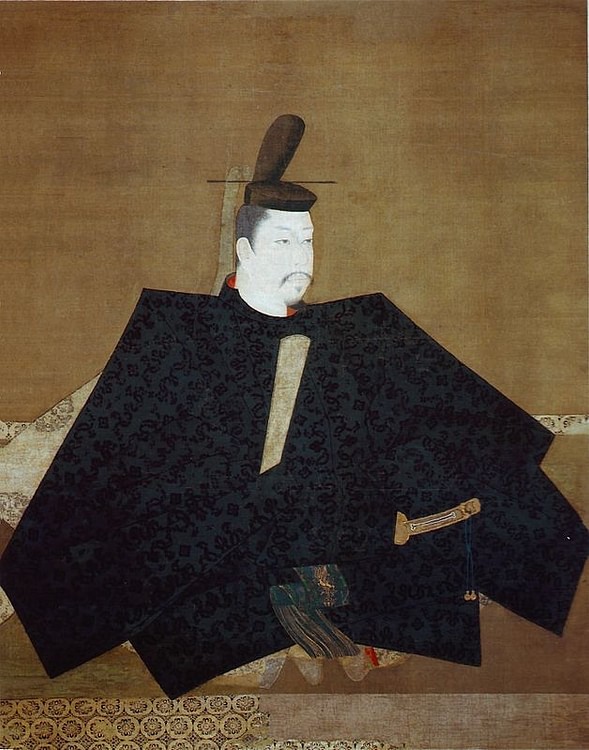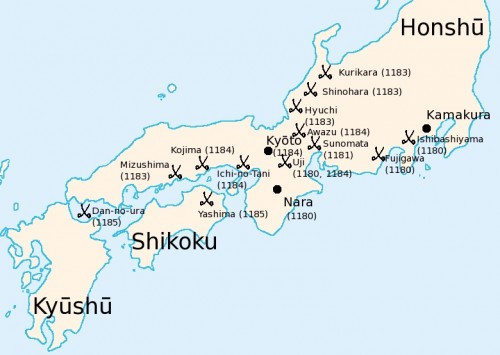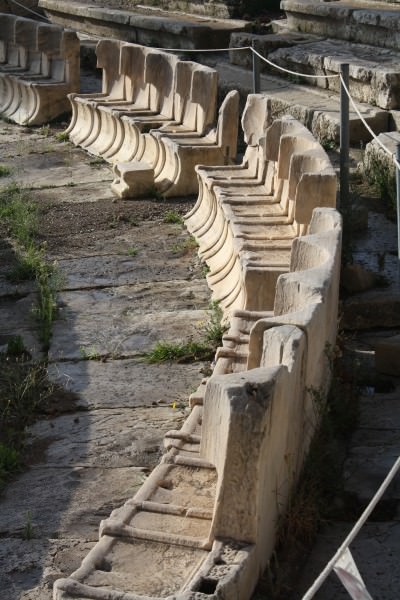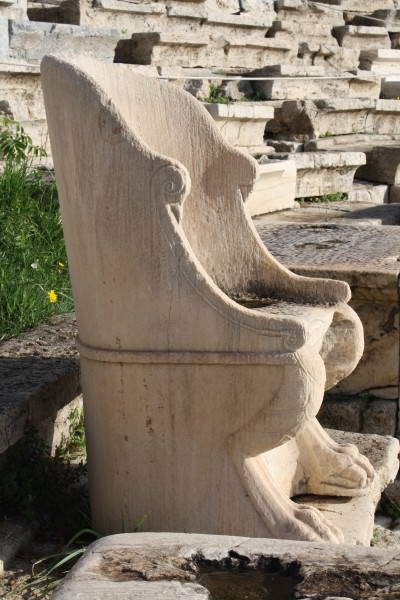Genpei War › Theatre of Dionysos Eleuthereus » Origins and History
Articles and Definitions › Contents
- Genpei War › Ancient History
- Theatre of Dionysos Eleuthereus › Antique Origins
Ancient civilizations › Historical places, and their characters
Genpei War › Ancient History
Definition and Origins

The Genpei War (1180-1185 CE), also known as the Taira-Minamoto War, was a conflict in Japan principally between two rival clans: the Minamoto and Taira, for control of the imperial throne. The civil war was punctuated by a typhoon, earthquake, famine and a plague but was finally ended at the decisive Battle of Dannoura when the defeated leader of the Taira, Tomomori, and the claimant to the throne Antoku, both committed suicide. In the aftermath of the war, the Kamakura Shogunate was established by Minamoto no Yoritomo and the military would go on to dominate Japanese government for centuries to come.
BACKGROUND
The Genpei War ( Genpei No Soran ) was a civil war for dynastic control in Japan between two powerful clan groups who each claimed a rightful inheritance to the imperial throne. From the 9th century CE, the process known as 'dynastic shedding' removed individuals from the dynastic lineage because the royal family became too large and too costly to maintain. With emperors having as many as 50 children, even direct descendants were removed from the royal line and given one of two family names: Minamoto (aka Minamoto-Shi or Genji) or Taira (aka Hei-Shi or Heike). Both groups were militarily powerful and a bitter rivalry developed between them. The aristocracy at court depended on one of the families according to their particular allegiance.
Almost inevitably, armed conflict broke out between these rivals, notably in the 1156 CE Hogen Disturbance when the two sides claimed the throne vacated by the death of retired emperor Toba. The retired emperor Sutoku was supported by Tameyoshi, head of the Minamoto and some factions of the powerful Fujiwara clan led by Yorinaga. Meanwhile, the then emperor Go-Shirakawa was supported by Tameyoshi's eldest son, who joined with the Taira and other members of the Fujiwara, led by Tadamichi, Yorinaga's brother. The Go-Shirakawa side, with help from the military commander Taira no Kiyomori, quashed the rebellion, and Tameyoshi was executed.
TWO REBELLIONS & TWICE THE TAIRA CLAN HAD PREVAILED, BUT FOR THE MINAMOTO, IT WOULD BE THIRD TIME LUCKY.
1160 CE saw another outbreak in clan hostilities with the Heiji Disturbance. Minamoto no Yoshitomo, jealous at the rewards and prestige won by Taira no Kiyomori following the Hogen Disturbance, seized the throne in 1159 CE while his rival was away from court. Taira no Kiyomori swiftly returned to restore order and Yoshimoto was killed. Two rebellions and twice the Taira clan had prevailed so that they were now the most powerful family in Japan. For the Minamoto, though, it would be third time lucky.
Taira no Kiyomori enjoyed even greater rewards now that he had quashed two 'disturbances' to the status quo and he was made Grand minister of state ( daijo daijin ) in 1167 CE. From then on, though, Kiyomori began to lose important allies, notably his old supporter the emperor Go-Shirakawa, now retired, who plotted to assassinate Kiyomori in 1177 CE following his attempt to promote a Taira prince. Trouble was, once again, brewing at court. A failed attempt by Kiyomori to move the court from Kyoto to Kobe was followed in 1180 CE by him audaciously putting his grandson Antoku, a mere two-year-old, on the throne at Kyoto. Antoku was the son of Emperor Takakura and his wife was Kiyomori's daughter. At this, the Minamoto had had enough, and with the support of Mochito, the son of ex-emperor Go-Shirakawa, civil war broke out.
WAR
The war began with warriors challenging and, in several places across the country, overthrowing Taira authority. The Taira court responded by sending an army of 70,000 to near Mt. Fuji to meet the rebel army led by Minamoto no Yoritomo. Yoritomo had some 200,000 men at his command as he was able to attract many rebels to his cause who had long been disgruntled with the Taira administration and particularly its redistribution of land rights. Realising they were greatly outnumbered the Taira force withdrew back to the capital, a capitulation which further swelled Yoritomo's numbers. The Minamoto did not pursue the enemy and, for the time being, concentrated on consolidating their almost total control of the eastern part of Japan.

Battles of the Genpei War
Taira no Tomomori was the son of Kiyomori who died of fever in 1181 CE and, like his father, he was a gifted commander. He enjoyed early successes in the first years of the Genpei war, notably against forces led by Minamoto no Yorimasa in 1180 CE and by Minamoto no Yukie in 1181 CE at the Sunomata River. In another development, the Taira burned the great temples of Onjoji, Todaiji, and Kofukuji in 1181 CE in retaliation for their support of the Minamoto. This was a deeply unpopular act at the imperial court and roused the resentment of the Fujiwara clan, the Kofukuji being their temple. Thus the civil war raged on and was made more complicated by clan members fighting on opposite sides against their kinfolk and bitter fighting and rivalry for resources even within each clan group.
The Genpei War came at a particularly bad moment for the Japanese people as within the space of five years they had to endure several natural disasters and their consequences. A typhoon hit the island in 1180 CE, a plague and famine came in the next two years, and then, in 1184 CE, there was a devastating earthquake. These events and the consequent hardships of the Japanese people are described in Kamo no Chomei's 1212 CE work Hojokin ('Tales from My Ten Foot Square Hut'), and, of course, they severely disrupted the progression of the war and prohibited any swift conclusion for either side.
YORITOMO STRENGTHENED HIS POSITION BY RETURNING PREVIOUSLY CONFISCATED LANDS TO THE TEMPLES & NOBILITY, & HE WAS LENIENT IN HIS TREATMENT OF PRISONERS.
While Yoritomo was consolidating his grip on the Kanto region, the Taira administration had to deal with another foe. Kiso Yoshinaka, a cousin of Yoritomo, was causing havoc in the Kiso Mountains of Shinano and, in 1183 CE, he defeated a large Taira army at Kurikara in Etchu, clearing the way for an assault on Kyoto.
In 1183 CE, Taira no Tomomori, the young Antoku, and most of the Taira clan fled Kyoto when it was finally occupied by the Minamoto. This force was led by Yoshinaka, who rashly declared himself seii taishogun or shogun (generalissimo). Yoshinaka pursued Tomomori but, with a depleted army, was defeated at Mizushima Bay and returned to Kyoto. Yoritomo, keen to avoid any competition as Minamoto clan leader, sought to remove his unruly cousin by sending a small force to assassinate him. In the event, two defeats at Uji and Seta outside Kyoto sealed Yoshinaka's fate, and he committed suicide. Yoritomo also strengthened his position by returning previously confiscated lands to the temples and nobility, was lenient in his treatment of prisoners, and received recognition from Go-Shirakawa of his authority in the east.
The Taira fleet had sailed away from the debacle of Kyoto, but they had regrouped at Kyushu, and from their naval base on the island of Yashima, they now controlled the Inland Sea. However, it was on land that Yoshitsune, younger brother of Yoritomo, attacked, inflicting a serious defeat at Ichinotani in 1184 CE.
In 1185 CE Yoritomo sent another of his brothers, Noriyori, with a second army to the coast while Yoshitsune attacked the base at Yashima. Once again fleeing and pursued by Yoshitsune, the Taira were caught up and Tomomori was defeated at the brief naval Battle of Dannoura ( Dannoura no Tatakai ) in the Strait of Shimonoseki at the tip of Honshu island. In typical samuraifashion, Tomomori committed suicide, throwing himself into the sea, and the widow of Kiyomori followed suit with the six- or seven-year-old Antoku in her arms. The Taira clan would never regain its former position.
AFTERMATH
Following victory Yoritomo formed a military government at his personal base of Kamakura and declared himself shogun, an ancient title previously only given by emperors to commanders for specific campaigns. It was the beginning of the Kamakura Shogunate (1192-1333 CE). Japan would endure military government for the next seven centuries. The Battle of Dannoura, with its tragic ending for the young Taira would-be emperor, became a popular subject for later Japanese literature and theatre.
This article was made possible with generous support from the Great Britain Sasakawa Foundation.
Theatre of Dionysos Eleuthereus › Antique Origins
Ancient Civilizations
The theatre of Dionysos Eleuthereus on the south slope of the acropolis of Athens was first built in the 6th century BCE.Modified and expanded over the centuries, it is the oldest Greek theatre and is the site where some of the most famous Greek plays from antiquity were first performed.
EARLY FORM
The theatre was part of a wider sanctuary dedicated to Dionysos Eleuthereus from the Archaic period. The cult to the Greek god of wine, merriment, and theatre was brought to Athens via the nearby deme of Eleutherai, although it can be traced back to Mycenaean times. A temple to Dionysos was first constructed by Peisistratos in the 6th century CE, and a circular area of tramped earth nearby was reserved for religious ceremonies where spectators took their seats on the hillside. Eventually this space evolved into a purpose-built theatre where Greek comedies and tragedies were performed, themselves evolved from earlier religious practices which included singing, wine drinking, animal sacrifices, and the wearing of masks. The climax of the celebrations was the Great Dionysia held each year in March/April, during the month of Elaphebolion, where the most famous playwrights such as Euripides, Sophocles, and Aristophanes presented their plays in competition.

Theatre of Dionysos Eleuthereus, Athens
5TH CENTURY BCE REMODELLING
In the 5th century BCE rows of seats were added around the performing area ( orchestra ), the front rows being stone and the rest of wood. These seats formed the first cavea which had flights of steps rising to the highest rows thus creating cunei or wedge-shaped sections of seats. Parodoi or large gateways were built either side of the stage giving access to spectators. A stone rectangular stage building or skene was added at the end of the 5th century BCE. The skene had paraskenia or wings on each side.

Seats of the Theatre of Dionysos, Athens
4TH CENTURY BCE IMPROVEMENTS
The theatre was remodelled and made much more grandiose in 330 BCE by the archon Lykourgos. Additional rows of seats using limestone from nearby Piraeus were added to the cavea, as were two extra horizontal walkways ( diazoma ) between seat sections giving the theatre a capacity of up to 16,000. The front row seats were made more comfortable with the addition of 67 thrones carved in marble. These seats were reserved for VIP officials who even had their names inscribed on them. One central throne in particular was more splendid than the rest and reserved for the priest of Dionysos. Lykourgos re-vamped the stone stage building, too. Sloping access ramps were also added to each side of the theatre to facilitate the emptying of the cavea after a performance. At this time three bronze statues of the great tragedians Aeschylus, Euripides, and Sophocles were erected at the main east entrance.

Seat from the Theatre of Dionysos, Athens
ROMAN AGGRANDIZEMENT
In Hellenistic and Roman times the theatre continued to hold performances. The Romans, as they did to most Greek theatres across the empire, greatly enlarged the skene. Sulla ’s attack on the city also damaged the theatre in 86 BCE but restoration work was subsequently carried out. In the 1st century CE Nero once again added a monumental Romanesque stage building which reduced the now marble stage area to its semi-circular form still seen today. From this period six marble statues of Silenos, the aged companion and tutor of Dionysos, survive which once stood on the stage.
A low speaker's platform ( bema ) was added in front of the skene in the 2nd or 3rd century CE. The bema was decorated with marble reliefs depicting myths of Dionysos in the 5th century CE by the archon Phaidros and these, albeit weather-damaged, are still visible today.

Sculptural Decoration, Theatre of Dionysos, Athens
LATER HISTORY
In the mid-5th century CE a Christian Basilica was constructed in the east parodos of the theatre. In the 13th century CE the theatre was incorporated into the Rizokastro fortification wall which ran around the base of acropolis. Over subsequent centuries many of the acropolis monuments, including the theatre, gradually became covered in earth fill. The theatre was first excavated in 1838 CE by the Archaeological Society of Athens, a process continued in the 1860s and again in the 1880s CE.Further excavation and some restoration of the theatre were first carried out in the 1980s CE and continue today.
LICENSE:
Article based on information obtained from these sources:with permission from the Website Ancient History Encyclopedia
Content is available under License Creative Commons: Attribution-NonCommercial-ShareAlike 3.0 Unported. CC-BY-NC-SA License